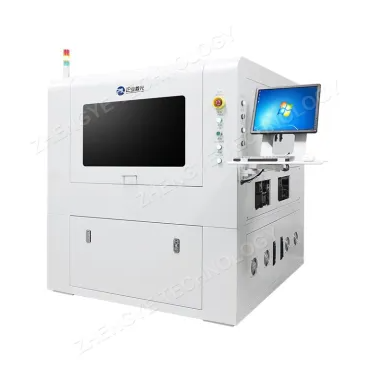UV Laser Cutting: Advancements and Applications
UV laser cutting has revolutionized manufacturing processes across various industries, offering unparalleled precision and efficiency. This cutting-edge technology utilizes ultraviolet (UV) lasers to create intricate designs and precise cuts in a wide range of materials. In this article, we explore the principles, advancements, and applications of UV laser cutting, along with its significance in diverse fields.

How Does UV Laser Cutting Work?
UV laser cutting is based on the principle of focused light energy. The process involves directing a high-intensity UV laser beam onto the material's surface. The energy from the laser beam is absorbed by the material, causing localized heating and vaporization. As the material vaporizes, a narrow and precise kerf is formed, resulting in a clean and accurate cut. This level of precision makes UV laser cutting ideal for applications that demand intricate detailing and high-quality outputs.
Advancements in UV Laser Cutting
Over the years, UV laser cutting technology has seen remarkable advancements, further enhancing its capabilities. One significant development is the introduction of nanosecond and picosecond lasers. Nanosecond lasers provide higher pulse energies, making them suitable for cutting thicker materials with ease. On the other hand, picosecond lasers offer exceptional edge quality and reduced heat-affected zones, making them perfect for delicate materials and high-precision applications.
Another area of improvement lies in beam delivery systems. Innovative technologies, such as galvanometer scanners, have optimized the speed and accuracy of UV laser cutting. These systems enable rapid movement of the laser beam, allowing for intricate and complex patterns to be cut in a shorter amount of time.
Additionally, intelligent processing techniques have been integrated into UV laser cutting systems. Real-time monitoring and feedback control mechanisms ensure optimal cutting parameters, allowing the technology to adapt to varying material properties. This results in improved cutting performance and overall efficiency.
Applications of UV Laser Cutting
The versatility of UV laser cutting has led to its adoption in various industries, each benefiting from its unique capabilities.
In the electronics and semiconductor industry, UV laser cutting plays a vital role in the micro-machining of circuit boards and semiconductor components. The precision and reliability achieved through this technology are crucial in meeting the demanding requirements of electronic devices.
The medical device manufacturing sector also benefits significantly from UV laser cutting. It allows for the creation of intricate components used in devices like stents, catheters, and implantable devices. The precise cuts and minimal thermal impact ensure that the final products meet the stringent quality standards of the medical field.
In the automotive industry, UV laser cutting is employed to manufacture lightweight and durable components such as airbags, sensors, and fuel injectors. These components contribute to improved vehicle performance and safety.
The aerospace and aviation sectors have also embraced UV laser cutting for fabricating complex components. This technology allows for the production of lightweight parts, contributing to enhanced fuel efficiency and performance.
Even the jewelry and fashion accessory industry has harnessed the potential of UV laser cutting. The technology enables precise engraving and cutting of intricate designs, resulting in unique and exquisite jewelry pieces.
UV Laser Cutting vs. Other Cutting Technologies
When comparing UV laser cutting to other cutting technologies, several key advantages come to light.
CO2 laser cutting, while widely used, may not match the precision and minimal heat-affected zone achieved by UV laser cutting. UV lasers excel in handling delicate and heat-sensitive materials.
Waterjet cutting, on the other hand, is excellent for thicker materials but may not provide the same level of precision as UV laser cutting, especially for intricate patterns.
Plasma cutting is known for its effectiveness with thicker materials, while UV laser cutting thrives in finer detailing and cleaner cuts in thinner materials.
Advantages of UV Laser Cutting
The advantages of UV laser cutting have made it a preferred choice in numerous applications:
High Precision and Accuracy: UV laser cutting ensures exceptional precision, allowing manufacturers to create intricate designs and achieve tight tolerances in their products.
Minimal Heat-Affected Zone (HAZ): With minimal thermal impact on the material, UV laser cutting reduces the risk of distortion and damage, ensuring the integrity of the cut material.
Non-Contact Cutting: UV laser cutting is a non-contact process, eliminating the need for physical contact with the material and minimizing the risk of contamination or damage.
Versatility with Various Materials: UV laser cutting is compatible with a wide range of materials, including metals, plastics, ceramics, and composites, offering versatility in manufacturing processes.
Challenges and Limitations
While UV laser cutting offers numerous advantages, there are some challenges and limitations to consider:
Material Thickness Constraints: UV laser cutting may have limitations in cutting thicker materials, as it is most effective for precise cutting in thin to medium thicknesses.
Initial Investment Costs: The initial setup and investment in UV laser cutting equipment can be significant; however, the long-term benefits in terms of precision and productivity outweigh the costs.
Maintenance and Safety Measures: Regular maintenance and adherence to safety protocols are crucial to ensure optimal performance and prevent accidents when working with UV laser cutting systems.
Conclusion
UV laser cutting has transformed the manufacturing landscape, enabling precise and efficient cutting processes across various industries. With advancements in technology and its ability to cater to diverse materials, UV laser cutting continues to drive innovation and enhance product quality. As manufacturers seek more intricate designs and precise outputs, UV laser cutting will undoubtedly play a pivotal role in shaping the future of manufacturing.
UV Laser Cutting manufacturer, click here, to explore the cutting-edge UV laser cutting solutions for your business needs.





Comments
All Comments ( 0 )